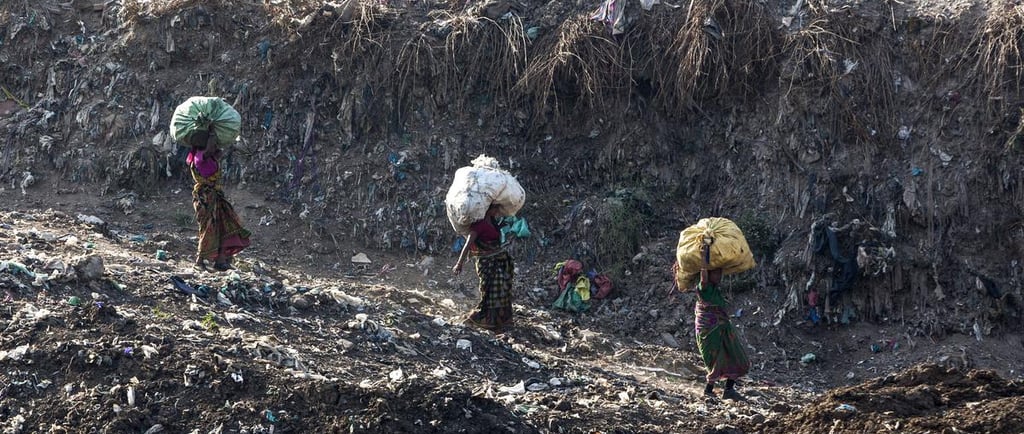The Blatant Discrepancy in Delhi’s Waste Management: A Closer Look at MoEFCC’s Claims
The article highlights significant discrepancies between the Ministry's reported data and the ground realities, particularly focusing on Delhi's lack of adequate sanitary landfill facilities. With the Supreme Court warning of a looming public health emergency and over 3,000 open dumpsites still operational nationwide, this piece highlights the urgent need for transparency and sustainable waste management solutions.
WASTE MANAGEMENT


In an answer to a question asked in parliament on July 29th this year, the Ministry of Environment, Forest and Climate Change (MoEFCC) presented statistics on waste management in Delhi that have raised more questions than answers. According to the Ministry, Delhi generates 11,108 tonnes per day (TPD) of waste, of which 5,280 TPD is processed or treated, and 5,828 TPD is landfilled. At first glance, these figures may seem to reflect a well-structured waste management system. However, a closer examination reveals a glaring contradiction that undermines the credibility of these claims.
The Illusion of Sanitary Landfills in Delhi
MoEFCC’s report implies that Delhi’s waste is being responsibly managed, with the majority of it being disposed of in sanitary landfills. However, the reality on the ground tells a different story. Delhi’s first engineered landfill, located at Tehkhand, only became operational in March 2024. Before this, the city’s first so-called “sanitary” landfill site at Narela-Bawana began operations in 2017. This site, however, has a capacity of just 1,550 TPD—far below the 5,828 TPD that the Ministry claims is being landfilled.
A sanitary landfill, as defined by a leading journal “Science Direct”, is a method of disposing of waste on land without disturbing the environment and public health. This is achieved by efficiently utilizing engineering skills to confine the waste in the smallest practical area possible, before reducing the volume by covering it with a layer of earth to ensure the least exposure to air. Such a method is intended to minimize environmental impact and protect public health.
However, the reality in Delhi—and much of India—is far removed from this ideal. The term “sanitary landfill” does not even appear in the Ministry’s data, suggesting a disconnect between the reported figures and the actual conditions on the ground. What exists in many parts of India, including Delhi, are more accurately described as open dumpsites rather than sanitary landfills. These sites lack the engineering controls and environmental protections that are fundamental to the concept of sanitary landfills.
Moreover, while Delhi does have four Waste-to-Energy (WTE) plants at Okhla, Ghazipur, Narela, and the recently operational Tehkhand, these facilities are not sanitary landfill sites. The distinction is crucial because WTE plants while contributing to waste processing, do not eliminate the need for proper landfilling practices. The reality is that much of the city’s waste ends up in open dumps, exacerbating environmental and health risks.
Given these facts, it’s hard not to view the Ministry’s numbers as misleading. How can over 5,800 TPD of waste be landfilled at a sanitary site when the city’s existing facilities, including the recently operational Tehkhand site, simply do not have the capacity to handle such volumes?
The Supreme Court’s Warning: A Looming Public Health Emergency
The situation is so dire that it has drawn the attention of the Supreme Court of India. On July 26, a Bench headed by Justice A.S. Oka described the state of solid waste management in Delhi as “sorry” and warned that it could lead to a public health emergency. The Court’s remarks were based on an affidavit from the Municipal Corporation of Delhi (MCD), which admitted that there are no adequate facilities in the city until 2027 to treat the 11,000 tonnes of solid waste generated daily. Adding to the gravity of the situation, Delhi authorities themselves admitted in the Supreme Court earlier this year that 3,800 TPD of waste goes untreated each day in the city.
This admission starkly contrasts with the MoEFCC’s optimistic figures and underscores the urgent need for realistic and effective waste management solutions in the capital.
A National Perspective: Solid Waste Management Across India
The issue of waste management is not confined to Delhi alone. MoEFCC’s report claims that India as a whole generates 1,70,338 TPD of waste, out of which 1,56,449 TPD is collected, and 41,455 TPD is landfilled at sanitary landfills. While these figures suggest a significant effort to manage waste responsibly, the situation on the ground tells a different story.
According to the Central Pollution Control Board’s (CPCB) latest data, India still has 3,159 operational dumpsites. Uttar Pradesh tops the charts with 609 dumpsites, followed by Madhya Pradesh with 378, and Maharashtra with 327. These numbers highlight the widespread reliance on outdated, unscientific dumping grounds that pose severe environmental and public health risks. The figures reported by the Ministry do not adequately account for the vast amounts of waste that are either left uncollected or dumped in open, unregulated areas.
Moreover, the emphasis on landfilling as a primary solution overlooks the need for more sustainable waste management practices. With the capacity of existing sanitary landfills falling short, there is an urgent need to focus on waste reduction, recycling, and composting initiatives. These practices not only minimize the amount of waste that ends up in landfills but also help conserve resources and reduce pollution.
The Need for Transparency and Accountability
The discrepancies in the MoEFCC’s report highlight a broader issue of transparency and accountability in India’s waste management practices. Accurate data is crucial for informed decision-making, and the public has a right to know the true state of waste management in their cities and towns. Misleading figures not only distort the reality of the situation but also hinder efforts to address the underlying problems.
In conclusion, while the MoEFCC’s report may paint a rosy picture of waste management in Delhi and across India, the reality is far from ideal. The discrepancies in the data, combined with the Supreme Court’s warning, not only reveal gaps in the current system but also underscore the urgent need for a more honest and effective approach to managing the country’s waste.
